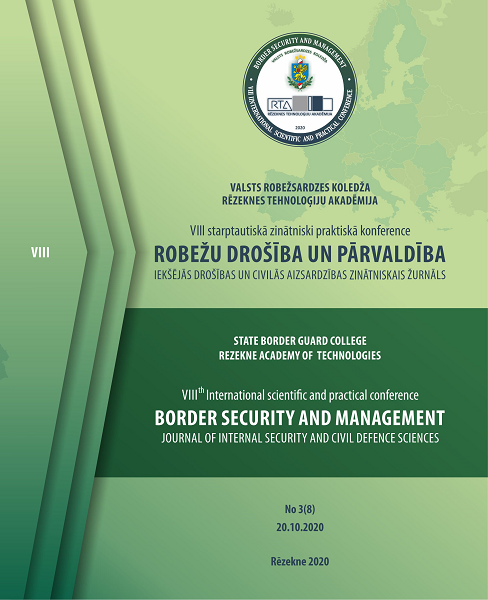EU BORDER SECURITY – THE DRIVERS AND BARRIERS OF BORDER GUARDING AUTHORITIES MOTIVATION IN TECHNOLOGICAL INNOVATION. CASE OF LATVIA
DOI:
https://doi.org/10.17770/bsm.v3i8.5367Keywords:
border, innovation, Latvia, motivation, securityAbstract
With the dynamic development of modern society, ensuring the security and control of the state border is the simultaneous goals of both internal and external security of the country. Consequently, it is vitally important to identify and develop tools and ways to address emerging challenges. In the current climate, private and public organizations are required to be up-to date with technological advancements in order to provide competitive, relative and effective solutions and services for inhabitants in all areas. Technological innovation is an important and even compulsory element of the modern organization, which stimulates continuous development and potential growth. There are many innovative ideas within other industries and universities where joint funds could be sort to allow the delivery of innovative solutions that would benefit such law enforcement agencies as border guarding authorities. A significant problem is that there appears to be a lack of interest from the respective law enforcement organizations in participating in consortiums, which is necessary for submission of any proposal. Jon Freemans` Analytical framework for understanding of innovation process used to under pin the main concepts of the research proposed in this thesis. This research involved a series of interviews and questionnaires designed to analyse the perceptions of the drivers and barriers of the State Border Guard of Latvia. From detailed results analysis, a list of general recommendation been established for Border Guarding Authorities in order to improve its motivation for participation in the projects related development of the technological innovation in the field of border security by conducting internal measures and improving network/connection building outside of the organization.
References
`Research` in Oxford Advanced Learner`s Dictionary. (2015). International Student`s Edition, Ne 9th edition, Oxford University press.
ARUNDEL, A., & HUBER, D. (2013). From too little to too much innovation? Issues in measuring innovation in the public sector. Structural Change and Economic Dynamics, Vol. 27, pp.146– 159.
BEKKERS, V., & TUMMERS, L. (2018). Innovation in the public sector: Towards an open and collaborative approach. International Review of Administrative Sciences, vol. 84, no. 2, pp. 209–213.
COENEN, L., & DÍAZ LÓPEZ, F. J. (2008). Comparing systemic approaches to innovation for sustainability and Competitiveness. TNO Built Environment and Geosciences Business Unit Innovation and Environment, pp. 2, 7, 9, 29.
COX, K. et. al., RAND Europe. (2018). From lab to field: Challenges and opportunities for operationalising. Frontex, pp. 9., 23.
ETZKOWITZ, H., & LEYDESDORFF, L. (1995). The Triple Helix: university–industry–government relations: a laboratory for knowledge-based economic development, EASST Review, vol 14, pp.14–19.
European Union, Horizon 2020. Retrieved December 22, 2018, from http://ec.europa.eu/programmes/horizon2020/
European Union, Horizon Europe - the next research and innovation framework programme. Retrieved October 27, 2019, from https://ec.europa.eu/info/designing-next-research-and-innovation-framework-programme/what-shapes-next-framework-programme_en
European Union, Science, research and innovation performance of the EU, Strengthening the foundations for Europe's future. (2018). Retrieved January 17, 2019, from https://publications.europa.eu/en/publication-detail/-/publication/16907d0f-1d05-11e8-ac73-01aa75ed71a1/
European Union, Security Research and Innovation - Boosting effectiveness of the Security Union, 2017, pp. 2-12.
European Union. (2013). European Public Sector Innovation Scoreboard 2013. Retrieved January 8, 2019, from https://publications.europa.eu/en/publication-detail/-/publication/fe2a3b4b-3d7e-444d-82bc-790a0ab33737.
FREEMAN, J. et. al. RAND. (2015). Innovation Models: Enabling new defence solutions and enhanced benefits from science and technology. Retrieved January 21, 2019, from http://www.rand.org/pubs/research_reports/RR1114.html
GAULT, F. (2018). Defining and measuring innovation in all sectors of the economy`, Research Policy vol. 47, pp. 617–622.
LIU, Z. et al. (2018). Intellectual property protection, technological innovation and enterprise value - An empirical study on panel data of 80 advanced manufacturing SMEs. Cognitive Systems Research vol. 52, December 2018, pp. 741-746.
MALERBA, M. (2002). Sectoral systems of innovation and production. Research Policy, vol. 31, pp. 247–264.
PREECE, D., MCLOUGHLIN, I., & DAWSON, P. (2000) Technology, organizations and innovation` vol. 2, Theories Concepts and Paradigms II, ROUTLEDGE. Retrieved January 5, 2019, from Books google.lv.
ROBERTS, A., & TÕNURIST, P. (2018). Innovation is a many-splendoured thing`, Observatory of public sector innovation (OPSI). Retrieved January 2, 2019, from https://www.oecd-opsi.org/innovation-is-a-many-splendoured-thing/
SCHILLING, M. (2013). Strategic management of technological innovation. 4th ed. New York, US: McGraw-Hill, pp 46-47. Retrieved January 21, 2019, from www.studocu.com
TATE, M. et al. (2018). Managing the “Fuzzy front end” of open digital service innovation in the public sector. A methodology`, International Journal of Information Management, vol.39, pp. 186–198.
The European Parlament and the Council, REGULATION (EU) 2016/1624 OF THE EUROPEAN PARLIAMENT AND OF THE COUNCIL of 14 September 2016 on the European Border and Coast Guard and amending Regulation (EU) 2016/399 of the European Parliament and of the Council and repealing Regulation (EC) No 863/2007 of the European Parliament and of the Council, Council Regulation (EC) No 2007/2004 and Council Decision 2005/267/EC.






